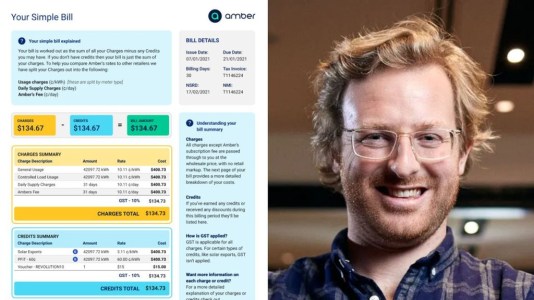Thousands face $400 surprise power bills—here's why you CAN'T fight it
By
Maan
- Replies 9
Customers of an Australian energy provider were stunned to learn they owed hundreds of dollars in unexpected charges after a major billing error.
Amber Electric admitted a glitch in its system caused incorrect wholesale rate calculations, leaving thousands undercharged for months.
Now, around one in five customers have been told they must pay back the difference—despite frustration over the company’s mistake.
In an email to affected users, Amber Electric’s co-CEO Chris Thompson confirmed that approximately 20 per cent of customers had been impacted.
The issue stemmed from a third-party billing system the company switched to two months earlier, which failed to correctly calculate rates for certain accounts.
Customers with controlled-load supply or older-style accumulation meters were hit hardest, with many receiving back-bills worth several hundred dollars.
One affected customer, who requested anonymity, revealed they were charged just 0.86 cents per kilowatt hour in one billing cycle instead of the correct 36.30 cents—resulting in a $280 adjustment.
Over two months, they were undercharged by nearly $400 and were told they must repay the amount over two future bills.
While Amber offered a $25 account credit and the option of a payment plan, some customers felt it was unfair they were being forced to cover the shortfall.
‘What an absolute kick in the guts on top of all the other cost of living pressures at the moment, this is the last thing we need,’ one customer, with the provider for nearly two years, shared.
‘If they cant run their books properly that’s not my problem, they should cop the cost and apologise for the distress this has caused.
‘Forcing customers to pay for their incompetence is just crazy, a token apology email just doesn’t cut it.’
Thompson apologised in the company’s statement, saying Amber took billing accuracy seriously and would be implementing additional automated testing to prevent future mistakes.
He explained that Amber’s only profit came from a flat $25 monthly fee, not from usage or supply charges, and that the company needed to recover the lost revenue to remain financially sustainable.
‘We take the trust our customers place in us extremely seriously, and a big part of that is that you can trust that the bills we send you are accurate,’ he wrote.
‘We do need to make sure we pass through the corrected amount to you to ensure we are financially sustainable.’
‘As a young, innovative company, we’re building something different in the energy market, and with that comes a level of complexity in our systems that isn’t common in the industry.’
Under rules outlined by the Energy & Water Ombudsman NSW, energy retailers can issue back-bills for undercharged amounts but must not charge for usage beyond nine months, add interest, or fail to provide clear explanations and repayment options.
Billing errors aren’t the only way power companies can leave customers paying more than they should.
Some providers use sneaky plan names and hidden price changes that make it harder to see when costs have quietly gone up.
If you want to know how these tactics work—and how to protect yourself—this next story is worth a look.
Read more: Energy providers use deceptive tactics to raise household bills

Should customers have to pay for a company’s mistake when they were undercharged through no fault of their own?
Amber Electric admitted a glitch in its system caused incorrect wholesale rate calculations, leaving thousands undercharged for months.
Now, around one in five customers have been told they must pay back the difference—despite frustration over the company’s mistake.
In an email to affected users, Amber Electric’s co-CEO Chris Thompson confirmed that approximately 20 per cent of customers had been impacted.
The issue stemmed from a third-party billing system the company switched to two months earlier, which failed to correctly calculate rates for certain accounts.
Customers with controlled-load supply or older-style accumulation meters were hit hardest, with many receiving back-bills worth several hundred dollars.
One affected customer, who requested anonymity, revealed they were charged just 0.86 cents per kilowatt hour in one billing cycle instead of the correct 36.30 cents—resulting in a $280 adjustment.
Over two months, they were undercharged by nearly $400 and were told they must repay the amount over two future bills.
While Amber offered a $25 account credit and the option of a payment plan, some customers felt it was unfair they were being forced to cover the shortfall.
‘What an absolute kick in the guts on top of all the other cost of living pressures at the moment, this is the last thing we need,’ one customer, with the provider for nearly two years, shared.
‘If they cant run their books properly that’s not my problem, they should cop the cost and apologise for the distress this has caused.
‘Forcing customers to pay for their incompetence is just crazy, a token apology email just doesn’t cut it.’
Thompson apologised in the company’s statement, saying Amber took billing accuracy seriously and would be implementing additional automated testing to prevent future mistakes.
He explained that Amber’s only profit came from a flat $25 monthly fee, not from usage or supply charges, and that the company needed to recover the lost revenue to remain financially sustainable.
‘We take the trust our customers place in us extremely seriously, and a big part of that is that you can trust that the bills we send you are accurate,’ he wrote.
‘We do need to make sure we pass through the corrected amount to you to ensure we are financially sustainable.’
‘As a young, innovative company, we’re building something different in the energy market, and with that comes a level of complexity in our systems that isn’t common in the industry.’
Under rules outlined by the Energy & Water Ombudsman NSW, energy retailers can issue back-bills for undercharged amounts but must not charge for usage beyond nine months, add interest, or fail to provide clear explanations and repayment options.
Billing errors aren’t the only way power companies can leave customers paying more than they should.
Some providers use sneaky plan names and hidden price changes that make it harder to see when costs have quietly gone up.
If you want to know how these tactics work—and how to protect yourself—this next story is worth a look.
Read more: Energy providers use deceptive tactics to raise household bills
Key Takeaways
- Amber Electric’s billing error affected about 20 per cent of customers.
- The issue was linked to a third-party system change made two months earlier.
- Some customers received back-bills of several hundred dollars.
- Energy retailers must follow strict rules when issuing back-bills.
Should customers have to pay for a company’s mistake when they were undercharged through no fault of their own?








